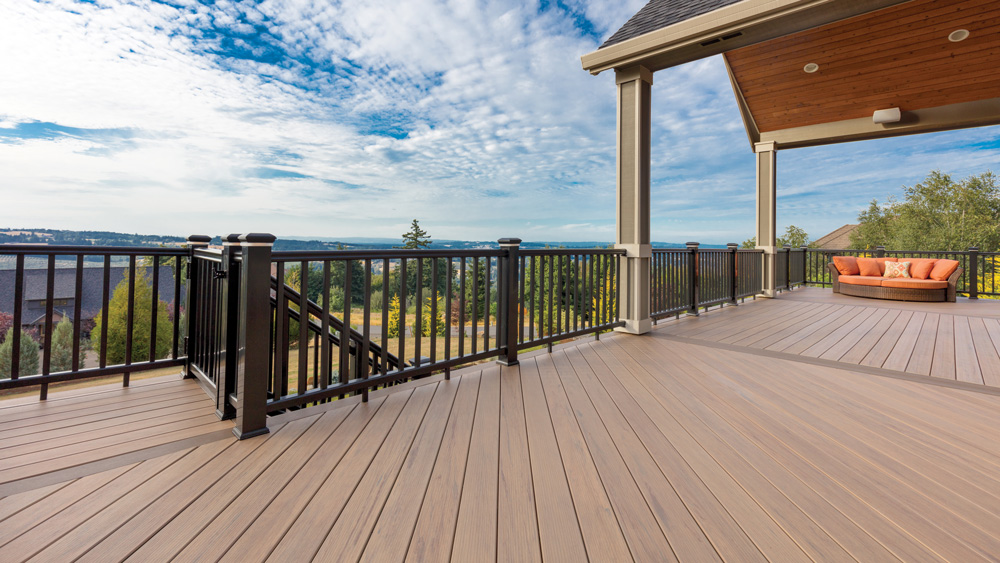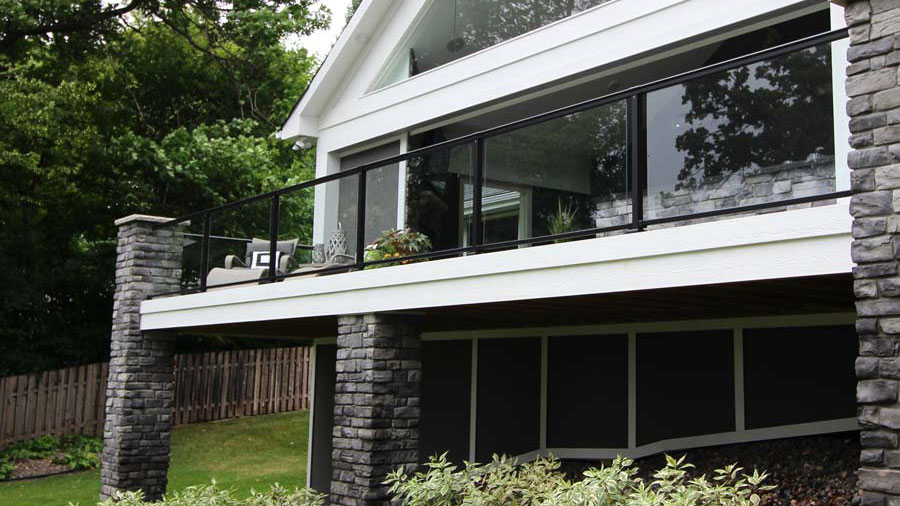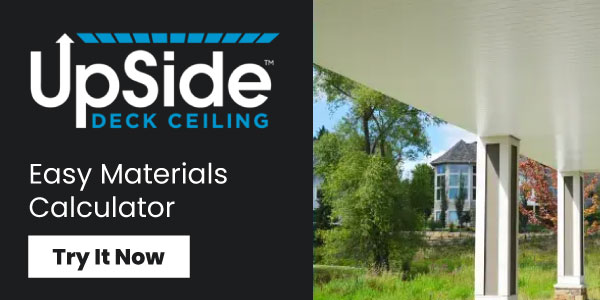Which Type Of Deck Railing Is Best For My Deck?
The right deck railing can completely transform your deck - in both function and character. But with a huge range of different railing types and styles on the market, how do you find the railing that best fits your deck?
With our guide, you'll be able to compare the pros and cons of popular railing styles to find the one that best fits your deck vision - plus find quick recommendations of the top railing types for decks with a view, best DIY deck railings, and more.

Table of Contents
- Benefits of Different Deck Railing Types
- Benefits of Metal Railing
- Benefits of Composite Railing
- Benefits of Cable Railing
- Benefits of Vinyl Railing
- Benefits of Glass Railing
- Benefits of Wood Railing
- Best Deck Railings For A View
- Best Deck Railings For DIY Installation
- Best Traditional Deck Railings
- Best Modern Deck Railings
Benefits of Different Deck Railing Types
There's a huge range of deck railing types on the market - but most of them fit into one or more of these six major categories:
- Metal Railing
- Composite Railing
- Cable Railing
- Vinyl Railing
- Glass Railing
- Wood Railing
We'll run through the pros and cons of each type below:
Benefits of Metal Railing
- Strong and stable even as temperatures change
- Incredibly low-maintenance
- Stylistically versatile
- Lots of DIY-friendly options

Metal railing is strong, modern, and low-maintenance. Typically made of powder-coated aluminum or steel, metal railing presents a smooth, polished surface that looks classy and luxurious, while also holding up very well even in harsh climates.
The strength of metal allows for skinnier posts and rails, allowing for more of a minimalist look, though you can still find more traditional-looking options. Metal railings are also generally easy to assemble - especially systems with pre-welded railing panels, like Fortress FE26 or Deckorators Contemporary.

Cons: Metal railing is a bit more expensive than wood, though the maintenance costs with wood add up much more over time. Metal railing can sometimes look out of place in very traditional settings, unless you can find a very traditional-looking system like AFCO Pro. And some homeowners don't like that metal railing gets hot in direct sunlight
Benefits of Composite Railing
- Classic, traditional looks
- Low-maintenance and long-lasting
- Lots of color options

If you love the more traditional look of thick wood railing, composite railing is a perfect low-maintenance enhancement of the same style. Composite railing is made from a mixture of natural wood fibers and synthetic plastics, with the wood adding strength and the plastics protecting the wood from weathering in the elements.
Composite railings are typically thick and substantial, with wide post sleeves that slide over existing wood posts or metal structural posts. The composite material offers a wide range of color options that give the look of painted wood - but never require you to paint, repaint, or stain them.
Composite railings are ultra low-maintenance, only requiring some periodic cleaning to keep their classic good looks.

Cons: Composite railings are a bit more expensive than wood railing, and also not as strong as pure wood. However, with wood or metal posts underneath the post sleeves, composite railing systems are still completely code-compliant and structurally sound.
Benefits of Cable Railing
- Creates wide-open deck views
- Modern, unique styling
- Lots of customization options
- Can use existing wood or metal posts

While metal and composite railings typically refer to the material used for the posts and rails, cable railing takes its name from the cable runs in between the posts. Cable railing can use a variety of materials for the posts and rails, most commonly metal, composite, or wood.
Cable railing was developed in coastal regions to better highlight views of water - and boy does it succeed. If you have a deck near a lake, ocean, river, or other body of water, cable railing is ideal for highlighting your view.
The cables are thin, allowing more view to show through. The organic gray color nearly disappears into natural settings. And the cables are polished and twisted so they don't reflect the light or give off a shiny, distracting gleam. Instead, they absorb light and blend deeper into the view beyond.
Cable is a distinctly modern, industrial look that fits really well on decks with diverse textures like wood or stone.

Cons: Cable railing systems can get pricey, especially systems with complex cable fittings. It can be tricky to bend cable around the corners of your deck, often forcing you to cut a cable run off and start a new one. We recommend looking for a cable system with a specialized corner solution, like the Skyline Cable Railing above, or Key-Link Horizontal Cable , which has a specialized single corner post.
Benefits of Vinyl Railing
- Distinctive Cape Cod or Colonial looks
- Easy to maintain
- Keeps railing costs low

Vinyl railing delivers a very specific, very popular look that's right at home on Colonial-style or Cape Cod-style homes. Vinyl is especially low-maintenance and easy to clean, making it a perfect modern functional upgrade to painted wood railings.
Vinyl railing is made from premium synthetic material, like a composite railing, only without the natural wood fibers mixed in. To replace the strength of the wood, vinyl railing often has an aluminum framework inside the rails.
Vinyl is also typically a pretty cost-effective railing material, and vinyl railing is fairly friendly for DIY installation.

Cons: Vinyl railing doesn't hold its color quite as well as composite railing, fading in the sun or forming a chalky, white powder. When choosing a vinyl railing, we highly recommend choosing a railing made with premium vinyl material, like the lines we carry from Durables - these vinyl railings will hold up significantly better than cheaper vinyl systems.
Benefits of Glass Railing
- Premium, luxurious looks
- Opens up amazing deck views
- Strong and low-maintenance
_landscape_web.jpg)
If you really want to wow your guests, there's really no better option than glass. The most luxurious of railing styles, glass railing uses sturdy tempered glass panels (or occasionally tempered glass balusters) between metal, composite, or wood posts and rails.
Like cable railing, glass railing maximizes your view, removing visual obstructions and creating a railing you can see right through. There's nothing like the glint of the sun off of clean glass to signal luxury on your deck. Glass railing also makes your deck space feel bigger by letting in lots of natural light.

Cons: Glass railing tends to be more expensive, and a bit more complex to install than most other systems - but if it's luxury you want, it's worth the extra time and money. Glass can also be tricky to plan, as each panel has to be very precisely measured and cut to fit your space. That's why we offer custom-cut glass panels, so our team of professional project planners can make sure you get glass cut specifically to meet your deck's dimensions.
Benefits of Wood Railing
- Looks range from traditional to timeless
- Lots of baluster style options
- Earthy and natural aesthetic

Decades ago, most deck railings were made from standard wood. The look is classic and proven, bringing natural colors and textures to your space, and the cost of wood railing is generally lower.
Over time, though, wood weathers heavily in the outdoors. You can stain or seal it to protect it from the elements, but the costs can really add up - not to mention the hours of sweat put into staining and sealing every few years.
That's why more modern wood railings have replaced some of the less-structural elements with more durable metal. Wood railings with metal balusters and post caps creates a nice, timeless blend of the traditional and the modern.
You can also lean into wood's rustic appeal with hog wire mesh panels, like the Wild Hog panels in the railing below:

Cons: As noted above, wood railing is higher-maintenance and weathers faster than the other categories on this list. If you're choosing a wood railing, we recommend using lower-maintenance, longer-lasting materials for your infill and brackets to help the railing last longer. The Vista brand produces high-quality deck railing kits pairing high-end cedar wood with aluminum components for a wood railing built to last longer.
How To Pick The Best Deck Railing Type

So what deck railing type is best for your space? Here are a few recommendations based on some common deck priorities:
Best Deck Railings For A View
So you've got a stunning view. Your deck railing shouldn't get in the way of that! Here are our favorite deck railing styles to maximize an amazing view:
Glass Railing

Glass railing is king when it comes to deck views. Tempered glass panels provide a wide-open view with the least visual obstruction possible. Just check out the panoramic view above, created by TimberTech Classic Composite Glass Railing .
Shop Glass RailingCable Railing

As mentioned above, cable railing was developed along the coasts for the specific purpose of highlighting views of water. The organic gray color of the thin cables blends beautifully into any view of nature, and the polished, twisted strands of cable are designed to absorb light, not reflect it.
You can see that phenomenon at play in the Key-Link Cable Railing above, with the cables nearly disappearing into the lake view beyond.
Shop Cable RailingBest Deck Railings For DIY Installation
Every category of deck railing runs the spectrum when it comes to ease of installation - you can find easy-install or tricky-install options in any category. But overall, a few categories tend to have more DIY-friendly options:
Metal Railing

A few metal railings really lead the way when it comes to taking the stress out of the installation process.
Deckorators Contemporary Aluminum Railing comes in pre-welded railing panels, meaning you don't need to assemble your top rail, bottom rail, and balusters - they come already securely attached. All you need to do is attach the panel to your posts.
Fortress FE26 Steel Railing goes even one step further. That system also uses pre-welded panels, but also provides pre-bracketed posts, with the brackets already attached at the right spots. That saves tons of time spent measuring, marking, and attaching brackets with each section.
Shop Metal RailingComposite Railing

Composite railings are generally fairly easy to install, particularly if you're replacing an existing wood railing. Composite rails make a great wood deck refresh because you can keep your existing wood posts in place, covering them with composite post sleeves and avoiding the need to mount the posts for your deck railing.
Composite railings also typically come in straightforward kits that include the top rail, bottom rail, and balusters, like the Trex Select railing shown above.
Shop Composite RailingVinyl Railing

Vinyl railing can be easy to install for many of the same reasons as composite: you can reuse existing wood posts, and the components usually come in easy kits with the top rail, bottom rail, and balusters included. That's the case for the Durables Kirklees system shown above.
Shop Vinyl RailingBest Traditional Deck Railings
If you've got a traditional house with lots of character, these deck railings will mesh especially well with that classic style:
Composite Railing

Composite railing is the quintessential classic-look deck railing. The thick, substantial posts and sturdy rails call back to the tried-and-true look of wood railing while coating everything in a low-maintenance composite material.
The TimberTech Classic Composite railing above uses the Premier Rail top rail shape, an especially traditional rounded-off top rail that looks like intricately-carved wood.
Shop Composite RailingVinyl Railing

Vinyl is another totally classic look. While composite railing tends to stick with traditional baluster shapes (round or square), vinyl railing can often use ornate turned balusters like the Durables Ashington railing above.
Those ornate balusters will look especially great in traditional architecture like the Colonial porch in the picture.
Shop Vinyl RailingWood Railing

Wood railing also delivers a classic look, mostly because deck railings were made almost exclusively out of wood for so many years. We love to pair the traditional color and texture of wood with modern elements like metal balusters, post caps, or rail connectors, like the Vista Traditional railing above.
Shop Wood RailingBest Modern Deck Railings
On the flip side, if you're redoing your deck, you might want it to look totally modern and updated. If you have a modern home, or want to pair modern style with traditional elements for a timeless look, check out these especially-modern deck railing types:
Metal Railing

Metal is a distinctly modern look, with its smooth, consistent surfaces, clean lines, and minimalist aesthetic. Choosing a matte finish, like the Key-Link American Series textured black railing above, lends a distinctly modern vibe to any deck.
Shop Metal RailingCable Railing

Sleek cable runs are a brilliant, industrial addition to any deck. Creating even thinner lines than metal balusters, these cable runs are totally modern.
The most modern cable look you can get is pairing cable with metal rails and posts, like the Skyline Cable Railing system above. Even better: the drink rail adds a functional touch that's also decidedly modern, with a clean, flat top rail rather than a more traditional rounded-off shape.
Shop Cable RailingGlass Railing

The luxurious glint of glass also creates a totally modern vibe. Check out the gorgeous house above, with classy AFCO Glass railing complementing the home's very modern appeal.
Once again, pairing glass with metal make the most modern look possible, while glass within a composite frame is a bit more of a mix between traditional and modern.
Shop Glass Railing






